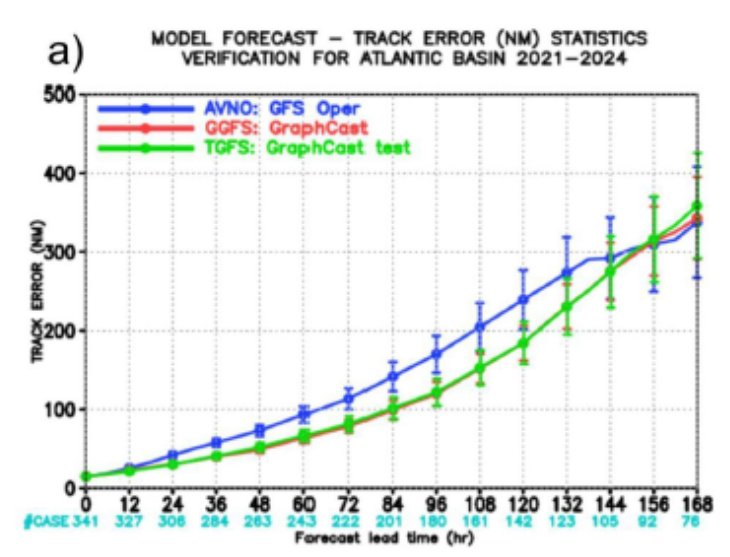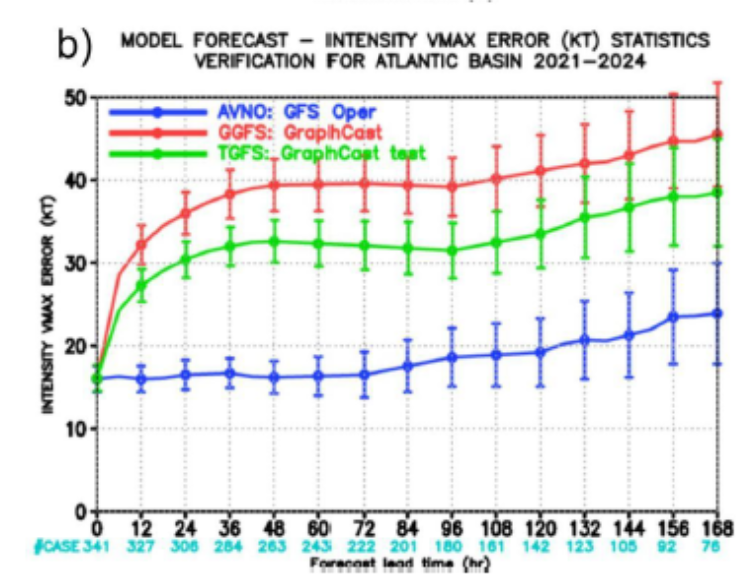Today we are sharing some early progress on Project EAGLE (Experimental AI Global and Limited-area Ensemble forecast system), which is a joint effort between NOAA Research Laboratories and the Earth Prediction Innovation Center (EPIC) in the Office of Oceanic and Atmospheric Research (OAR), and the National Weather Service (NWS).
Over the past couple of years NOAA researchers have embraced global and regional Artificial Intelligence (AI) based models (Frolov et al., 2024). In a short time, NOAA has delivered a reforecast database featuring community-developed AI models initialized with operational Global Forecast System data (Radford et al., 2025); an AI model trained on analysis from NOAA’s global data assimilation system (Tabas et al., 2025, Wang et al., 2025); a high-resolution model for Central U.S. severe weather (Flora and Potvin, 2025); and the first attempt to decouple AI forecasts from operational initial conditions (Slivinski et al., 2025). EAGLE is the next phase of this endeavor.
EAGLE is planned to provide NOAA and the Weather Enterprise with the ability to rapidly test, develop, and demonstrate in near-real time AI-based models for global and regional ensemble forecasting. Once fully-developed, EAGLE will enable researchers within NOAA and across the weather enterprise to rapidly test their AI models against trusted forecast metrics that are currently used to test and verify the performance of NOAA flagship systems like the Global Forecast System (GFS), the Global Ensemble Forecast System (GEFS), High Resolution Rapid Refresh (HRRR), and Warn on Forecast System (WoFS). We envision that this system will allow NOAA to identify the best performing AI innovations rapidly and advance them into near real-time demonstration that can deliver value to the Nation, save lives and property, and enhance the national economy.
Today EAGLE includes two components: Global-EAGLE-Solo and Global-EAGLE-Ensemble. Both of them are based on Google DeepMind’s GraphCast model (Lam et al., 2023) and are tuned by the NOAA Environmental Modeling Center (EMC) using NOAA data. The model runs on a 0.25-degree latitude-longitude grid (about 28 km) and 13 pressure levels. The model produces 16-day forecasts 2 times a day at 00Z and 12Z.
- Global-EAGLE-Solo: A demonstration environment for “deterministic” models that are initialized from a single GFS initial condition (IC). It is a complement to the existing NOAA GFS physics-based forecast. NOAA EMC re-trained the GraphCast model using Global Data Assimilation System (GDAS) data as inputs and training targets (Tabas et al., 2025).
- Global-EAGLE-Ensemble: A demonstration environment for ensemble forecasts, driven by the ICs of the operational GEFS. It is a complement to the existing NOAA GEFS physics-based ensemble forecast system. The weights for the Global-Eagle-Ensemble members are generated by fine-tuning the original GraphCast weights from DeepMind(c) with recent NOAA operational GDAS analysis. The resulting weights are effectively trained on the combination of European Centre for Medium-Range Weather Forecasts’s (ECMWF) fifth-generation reanalysis (ERA5), ECMWF high-resolution (HRES), and NOAA GDAS analysis. Multiple checkpoints were saved to form 31 global ensemble members (Wang et al., 2025).
The real time performance of the EAGLE systems will be monitored and compared to other NOAA models. Offline verification of the EAGLE component models is available from Tabas et.al. (2025) and Wang et al. (2025). Figure 1 (excerpted from Tabas et.al 2025), highlights the skill of track error and intensity of tropical cyclones, with the retrained and fine-tuned GraphCast models used in the current EAGLE configurations.
| (Figure 1) Performance of the fine-tuned Graphcast (red: similar to Global-Eagle-Ensemble) and GraphCast trained on the GDAS from scratch (green: similar to Global-EAGLE-Solo) compared to the operational GFS (blue). (a) Both versions of the GraphCast outperform forecasts of Tropical Cyclone (TC) track in the Atlantic basin. (b) Both versions of the GraphCast models underpredict TC intensity compared to the GFS forecast. However, the version of the GraphCast used by the Global-EAGLE-Solo (green) is less biased than the version of the GraphCast used by the Global-EAGLE-Ensemble (red). (Tabas et al., 2025) | |
Figures 2 and 3 show example output from the Project EAGLE demonstration.
What is next for project EAGLE?
EPIC will establish an open system for testing and verifying AI-based global and limited-area ensemble forecasts using NOAA’s trusted operational forecast metrics.
Project EAGLE will provide a research-to-demonstration pipeline that will identify promising AI forecast innovations across the community, facilitate inclusion of innovation in a near-real-time demonstration environment, and expedite integration of proven innovations into future operational implementations. This near-real-time environment will enable NOAA to experiment and utilize the best community practices for deploying advanced AI systems and disseminating their output to users at scale.
Future releases will provide the public with early versions of the AI models that are currently under development across the NOAA laboratories and development centers, including CONUS-wide, storm-resolving, nested, and coupled versions of AI forecast models. We expect that the future AI models from NOAA, will leverage common AI model infrastructure based on the Anemoi open-source framework from the European Centre for Medium-Range Weather Forecasts (ECMWF) and several of its Member States.
References:
Flora, M. L., and C. K. Potvin, 2025: WoFSCast: A Machine Learning Model for Predicting Thunderstorms at Watch-to-Warning Scales. Fully accepted, Geo. Res. Lett. https://doi.org/10.22541/essoar.172574503.30734251/v1
Frolov, S., K. Garrett, I. Jankov, D. Kleist, J. Q. Stewart, and J. Ten Hoeve, 2025: Integration of Emerging Data-Driven Models into the NOAA Research-to-Operations Pipeline for Numerical Weather Prediction. Bull. Amer. Meteor. Soc., 106, E437, https://doi.org/10.1175/BAMS-D-24-0062.1.E430
Lam, R., A. Sanchez-Gonzalez, M. Willson, P. Wirnsberger, M. Fortunato, F. Alet, S. Ravuri, T. Ewalds, Z. Eaton-Rosen, W. Hu, A. Merose, S. Hoyer, G. Holland, O. Vinyals, J. Stott, A. Pritzel, S. Mohamed, and P. Battaglia, 2023: Learning skillful medium-range global weather forecasting. Science, 382, 1416-1421, https://doi.org/doi:10.1126/science.adi2336.
Radford, J. T., I. Ebert-Uphoff, J. Q. Stewart, K. D. Musgrave, R. DeMaria, N. Tourville, and K. Hilburn, 2025: Accelerating Community-Wide Evaluation of AI Models for Global Weather Prediction by Facilitating Access to Model Output. Bull. Amer. Meteor. Soc., 106, E68–E76, https://doi.org/10.1175/BAMS-D-24-0057.1.
Slivinski, L. C., Whitaker, J. S., Frolov, S., Smith, T. A., & Agarwal, N. (2025). Assimilating observed surface pressure into ML weather prediction models. Geophysical Research Letters, 52(6). https://doi.org/10.1029/2024gl114396
Tabas, S. S., J. Wang, W. Lei, M. Row, Z. Zhang, L. Zhu, J. Peng, and J. R. Carley, 2025: GFS-Powered Machine Learning Weather Prediction: A Comparative Study on Training GraphCast with NOAA’s GDAS Data for Global Weather Forecasts. NCEP Office Note 521, 33. https://doi.org/10.25923/xd3y-wy31.
Wang J., S. S. Tabas, B. Fu, L. Cui, Z. Zhang, L. Zhu, J. Peng, and J. R. Carley, 2025: Development of a Hybrid ML and Physical Model Global Ensemble System. NCEP Office Note 522, https://doi.org/10.25923/7kpr-










